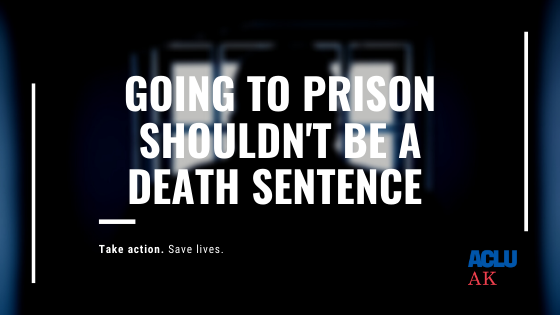COVID-19 could claim the lives of approximately 100,000 more people nationwide than current projections if jail populations are not dramatically and immediately reduced, according to a new epidemiological model released yesterday by the ACLU and academic research partners. The findings indicate that — even if communities across the United States continue practicing social distancing and following public health guidance — they will still experience much higher death rates if no substantial action is taken to reduce jail populations.
“This data should be a wake-up call for Governor Dunleavy, Department of Corrections Commissioner Nancy Dahlstrom, and anyone with the power to alleviate stress and save the lives of vulnerable individuals, but are choosing not to because an outdated, overly politicized, and factually unfounded view that does nothing but feed America’s addiction to mass incarceration,” ACLU of Alaska Executive Director Joshua Decker said. ““Hope is not a strategy or a plan. By not reducing the prison population, the Dunleavy administration is tempting fate and playing with lives by not taking the dramatic steps needed to reduce the risk.”
The U.S. is the largest incarcerator in the world, with just four percent of the world’s population and 21 percent of its incarcerated population. About 40 percent of all incarcerated people suffer from at least one chronic health condition, such as asthma or diabetes. This means the U.S. faces a unique challenge in mitigating the spread of COVID-19 and is likely facing a much higher death count than models based on data from other countries predict.
In Alaska, the prison population is aging and medically vulnerable. According to state data, between 2015 and 2019, the number of prisons age 60 and older grew by 26.5 percent. Additionally, four out of five incarcerated people have a substance use disorder, and 44 percent of the prison population have a diagnosed mental health issue.
The ACLU model used data pulled from more than 1,200 midsize and large jail systems around the country, whose surrounding communities account for 90 percent of the U.S. population. It found that, unequivocally, keeping people out of jail saves lives — both inside the jail and in the surrounding community. Other key findings from the model include:
- If a model that doesn’t account for jails predicts the U.S. death toll will be 100,000, our model shows that that projection undercounts deaths by 98 percent. Actual deaths, once we account for jails, could be more than double, rising to 200,000.
- Implementing swift, bold reforms to reduce arrests by 50 percent can save 12,000 lives in jails, and 47,000 lives in the surrounding communities.
- Aggressive action and policy change could save as many as 23,000 people in jail and 76,000 in the broader community if we stop arrests for anything but the five percent of crimes defined as most serious by the FBI — including murder, rape, and aggravated assault — and double the rate of release for those already detained.
- States that have begun to reduce their jail populations are quantifiably saving lives. Colorado, for example, has so far achieved a 31 percent reduction in jail population. Our model found this likely will save 1,100 lives — reducing total lives lost in the state by 25 percent.
- Every day that goes by without action means more people will die. Delaying action for a week could mean a difference of 18,000 lives lost in the U.S.
“The prevailing epidemiological models largely fail to take into account our incarceration rates and the complete absence of social distancing in our jails — which is why we had to build our own model,” said Lucia Tian, chief analytics officer, ACLU. “While we always knew that jails would have an impact on loss of life in this pandemic, the model shows us just how large that impact may be — that even under our best case scenarios, we could be looking at 100,000 more deaths. We can't save our community while ignoring our jails.”
The original model was developed by Dr. Nina Fefferman at the University of Tennessee, Dr. Eric Lofgren at Washington State University, and Dr. Kristian Lum from the University of Pennsylvania, in collaboration with Aaron Horowitz and Brooke Madubuonwu of the ACLU’s data analytics team, experts from the ACLU and other corrections organizations contributed expertise.
The ACLU of Alaska has attempted to work with the state leadership twice to reduce the stress in Alaska’s dangerously overcrowded and understaffed prisons. Neither Governor Dunleavy or Commissioner Dahlstrom have responded to the ACLU’s outreach or taken steps to reduce Alaska’s prison population, which disproportionately detains Alaska Native individuals.
Last week, the ACLU of Alaska launched a petition, calling on Alaskans to help us fight to save the lives of those who are already marginalized by a legal system built off systemic racism. The petition can be found, here[TS1] .
See the report, here.
See the ACLU of Alaska’s letters to state officials, here.
The original academic paper on Allegheny County can be found on MedRxiv, here.


